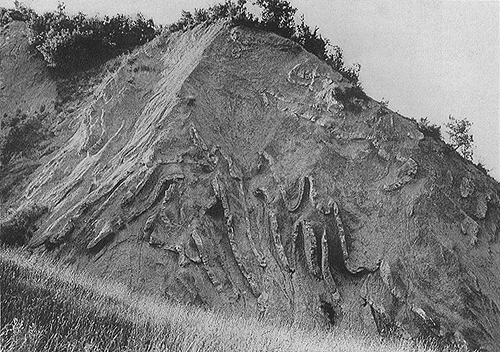
Deformations related to sliding and slumping
Plate 129

Deformations related to sliding and slumping
Plate 129
Landslides and subaqueous slides remove rock and sediment masses from slopes and accumulate them downhill. The movement is caused by the pull of gravity acting on the mass itself, in particular by the tangential (parallel to slope) or shear component of the mass weight. This force must overwhelm the resistance (shear strength) of the materials, which is function of their physical properties (cohesion, internal friction). By increasing the slope angle, the pulling force increases too, while the resistance does not vary. On the other hand, with a constant slope angle the resistance can be weakened by sediment liquefaction, excess pore water pressure, gas injection and other causes.
Underwater slides involve more or less compacted sediments and transfer them into deeper water. The volume of subaqueous slides is greater, on the average, than that of subaerial slides, the movement being favored by hydrostatic pressure that increases buoyancy and decreases friction.
In some cases, sliding masses are not deformed inside; they glide as rigid blocks on a slippery surface (slip plane ) where deformation is concentrated. Before the failure, this surface is a horizon of greater weakness, such as an underconsolidated layer with a high pore pressure. More commonly, sliding masses become disarticulated into a series of blocks, which move almost independently by sliding against each other along several slip surfaces. Eventually, deformation is diffused through the mass, as illustrated here; this is favored by the interbedding of materials of different "competence" (strength), represented in this outcrop by compacted sand and mud. Sand beds look like broken and folded strings (or the bolognese pasta "tagliatelle") with so-called cascade folding style. In mud beds, the deformation is more pervasive and less recognizable from a certain distance.
Is it possible to recognize the sense of movement in these folded structures? Sometimes it is, sometimes it isn't. It depends on the availability of certain information (see plates 131 and 134, for example). In the present case, the answer is no, because geometric data are insufficient: hinges and axial planes of folds dip in various directions, as do shear planes cutting the outcrop in blocks. In other terms, there is no preferred orientation of structures, which suggests that the movement of sliding masses has more degrees of freedom than tectonic movements occurring at deeper levels, which are more constrained by load and lateral confinement.
In conclusion, fossil slide structures are indicators of paleoslopes with some limitations; they witness to the former existence and instability of slopes, but not necessarily to their orientation.
Ancient slides are (improperly) called intraformational if they include intrabasinal materials, extraformational if composed by extrabasinal sediments or "exotic" rocks. Actually, what is "intra" or "extra" is not the process but the provenance of the materials. Intrabasinal sediments may have been originally deposited on either sloping or horizontal surfaces; in the latter case, tilting occurred after deposition, and can be inferred from the facies of slid beds. The turbidites shown in this picture, for example, were initially deposited on a flat deep sea plain.
Marnoso-arenacea Formation near Sarsina, northern Apennines.